
| University of Toronto | |
|
|
|
| Atmospheric Observatory | |

| University of Toronto | |
|
|
|
| Atmospheric Observatory | |
| Lab Facilities | ||||||||||||||||||||||||||||||||||||||||
| Below is a list of all the equipment in the lab. Click on the link to jump to a description of each instrument. | ||||||||||||||||||||||||||||||||||||||||
| Current Equipment at TAO: |
|
|||||||||||||||||||||||||||||||||||||||
| These are instuments that are installed at TAO year-round. | ||||||||||||||||||||||||||||||||||||||||
| Campaign Equipment | ||||||||||||||||||||||||||||||||||||||||
| These are instuments that are installed at TAO on an intermittent basis, alternating with other locations. | ||||||||||||||||||||||||||||||||||||||||
| Equipment Previously at TAO: | ||||||||||||||||||||||||||||||||||||||||
| These are instruments that are no longer operational. | ||||||||||||||||||||||||||||||||||||||||
| Current Equipment | ||||||||||||||||||||||||||||||||||||||||
| Fourier Transform Infrared Spectrometer | ||||||||||||||||||||||||||||||||||||||||
| The ABB Bomem DA8 Fourier
Transform (FTIR) Spectrometer has a maximum optical path difference
of 250 cm, resulting in a maximum resolution of 0.004 cm-1.
The FTS is equipped with KBr (700-4300 cm-1)
and CaF2 (1200-8500 cm-1)
beamsplitters. Attached to the front of the instrument are two
detectors, which are cooled with liquid nitrogen. The InSb
detector is responsive from 1800-8500 cm-1
and the HgCdTe (MCT) detector is responsive from 500-5000
cm-1. Before solar radiation
enters the spectrometer, it passes through one of six NDACC
standard filters. The filters only allow a specific region of the
infrared spectrum to enter the spectrometer. FTIR solar absorption spectra are recorded under clear-sky conditions. Measurements are semi-automated, involving an operator to start up and shut down the FTIR spectrometer and suntracker, cool the detectors with liquid nitrogen and choose filter sequences based on prior measurements. Currently, ABB Bomem's Process Control and Data Acquisition (PCDA) and GRAMS software is used in acquiring data and computing Fast Fourier Transforms. The SFIT2 and SFIT4 retrieval algorithms are used to derive total columns and some vertical profile information for a suite of trace gases, following recommendations of the NDACC Infrared Working Group. These data can be found on the NDACC archive.
Instrument History: - Operated on a continuous basis since 2001, with the exception of Aug-Sep 2004 and Dec 2006-Jan 2007 when no data were recorded because of a suntracker failure and Mar-Jun 2009 when no data were recorded because of an alignment issue. - Bomem conducted work to improve the alignment in 2002. - The MCT detector was replaced to improve sensitivity in November 2002. - The scanning mirror was replaced in April 2011. - The laser was replaced by a Bomen service engineer in September 2012. |
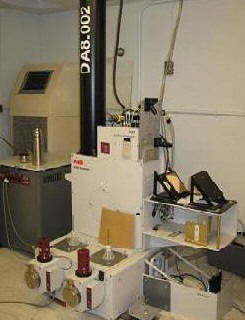 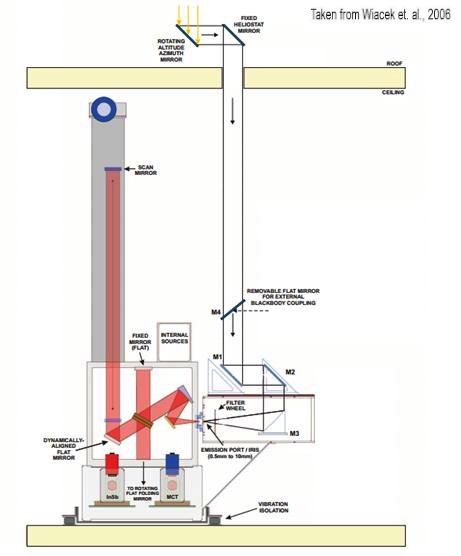 |
|||||||||||||||||||||||||||||||||||||||
|
|
Heliostat The heliostat or suntracker was built by Aim Controls (California) and captures the solar radiation for the DA8 spectrometer and some guest instruments. It is mounted on the roof and follows the Sun during the day, reflecting solar radiation from a mirror into the lab through an opening in the roof. The suntracker is driven by two Shinano SST57D stepper motors on altitude and azimuth axes which drive at a ratio of 5400:1. Once the radiation enters the lab, a series of mirrors are used to direct the solar beam into the instruments. |
|||
|
Brewer MKIV
Spectrophotometer A Brewer spectrophotometer is on loan from Environment Canada and was installed at TAO in March 2005. It is an automated UV-visible spectrometer that makes daily measurements of total ozone columns using direct solar observations. Over 80 Brewer spectrophotometers are used worldwide to monitor stratospheric ozone: the TAO Brewer is number 083. The TAO Brewer spectrophotometer contributes data to the World Ozone and Ultraviolet Radiation Centre (WOUDC) which includes data from over 500 stations. Data from the TAO Brewer and other stations can be found on the WOUDC website. Alan Brewer was a faculty member of the University of Toronto Physics Department from 1962 to 1977. Among his many accomplishments was the development of the Brewer spectrophotometer. |
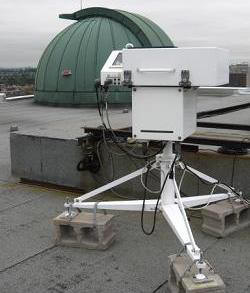 |
|
|
Custom-Built
Suntracker The University of Toronto (UT) Suntracker was developed at the University of Toronto and is installed in the TAO for testing purposes. Additional development is being done at Dalhousie University. The UT Suntracker is made from off-the-shelf parts using open-source software, and, once fully tested, the design and control software will be made publicly available. Two other versions of the UT Suntracker are installed at the Polar Environment Atmospheric Research Laboratory at Eureka, Nunavut for FTIR and UV-visible measurements. |
|
Weather
Station A Davis Vantage Pro Plus 2 weather station is used to record basic weather parameters, such as temperature, humidity, wind speed and direction, precipitation, and solar irradiance. Read more about our weather station and weather data |
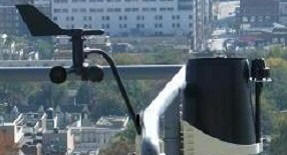 |
|
|
Vaisala Pressure
and Temperature Sensor A Vaisala PTU300 Class A Pressure and temperature sensor was installed at TAO in March 2013. A Vaisala PTB330 replaced the PTU300 in April 2020, the PTU300 log stopping in February 2020. The sensors measure temperature and pressure simultaneously with an accuracy of ± 0.15 hPa and ± 0.2 °C, respectively. |
|
Picarro Gas Analyzer A Picarro Gas analyzer was installed at TAO in the Fall of 2013 and is run by Environment Canada. It measures ambient levels of CO, CO2, CH4 and water vapour simultaneaously and continuously. It measures the spectral features of gas phase molecules using cavity ring-down laser spectroscopy. The gas analyzer has parts per billion precision and accuracy with very low drift. |
|
|
|
Pyranometer A Kipp & Zonen CM3 pyranometer was installed in 2007 and upgraded in 2010. It is operated by Environment Canada. The pyranometer measures solar irradiance, with the construction of the sensor allowing it to measure incoming solar energy over the whole hemisphere (180 degree field of view). It has a typical sensitivity of 10 µV/W/m² that varies less than 5% between -10 ºC and +40 ºC. |
|||
| Campaign Equipment | ||||
|
Systeme
d'Analyse par Observations Zenithales (SAOZ) The Systeme d'Analyse par Observations Zenithales (SAOZ) instrument was developed in the late 1980s at the Service d'Aeronomie of the Centre Nationale de la Recherche Scientifique in France. SAOZ instruments are deployed in a global network for measurements of stratospheric concentrations of trace gases important to ozone loss. SAOZ is a grating spectrometer with an uncooled 1024-pixel linear diode array. It records zenith-sky spectra with a 10-degree field-of-view between 270 and 620 nm, with a resolution of 1.0 nm. Throughout the day, spectra are recorded every thirty minutes, and are continuously obtained when the solar zenith angle is between 80 and 95 degrees. A SAOZ instrument has been deployed at TAO on an intermittent basis for several years, generally alternating with deployment at Eureka, Nunavut on springtime Arctic campaigns. |
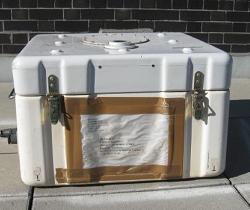 |
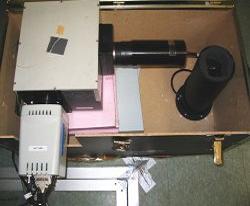 |
UV-Visible Grating Spectrometer The University of Toronto Ground-Based Spectrometer (UT-GBS) was assembled in 1998, and has been deployed on the MANTRA balloon campaigns at Vanscoy, SK, and on Arctic springtime campaigns at Eureka, NU since 1999. When it is not in the field, this instrument is installed at TAO. The instrument consists of an ISA/JY Triax 180 triple-grating spectrometer with diffraction gratings of 400, 600 and 1800 grooves/mm, providing spectral resolutions of 2.0, 0.9, and 0.5 nm (FWHM). The detector is a thermoelectrically cooled CCD array. The instrument is automated and records UV-visible absorption spectra of the light scattered from the zenith sky. These are analyzed using the technique of differential optical absorption spectroscopy (DOAS) to retrieve vertical columns of O3, NO2, and BrO. Vertical profiles of NO2 can also be derived from the measurements of NO2 slant column variation with solar zenith angle. |
|||
|
VLF Lightning
Detector From 2008 to 2010, a Very Long Frequency (VLF) lightning detector was installed at the TAO as part of a global effort to detect lightning across the Earth with high accuracy and efficiency and minimal cost. The detector calculates the arrival time of a lightning pulse in the VLF range using the Time Of Group Arrival (TOGA) method. When a lightning pulse is detected at more than three detectors, the location and time of the lightning is found by using the TOGA from each detector. Each detector is capable of detecting lightning from thousands of kilometers away. This instrument is no longer operational. |
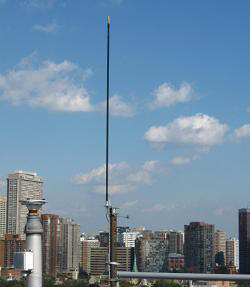 |